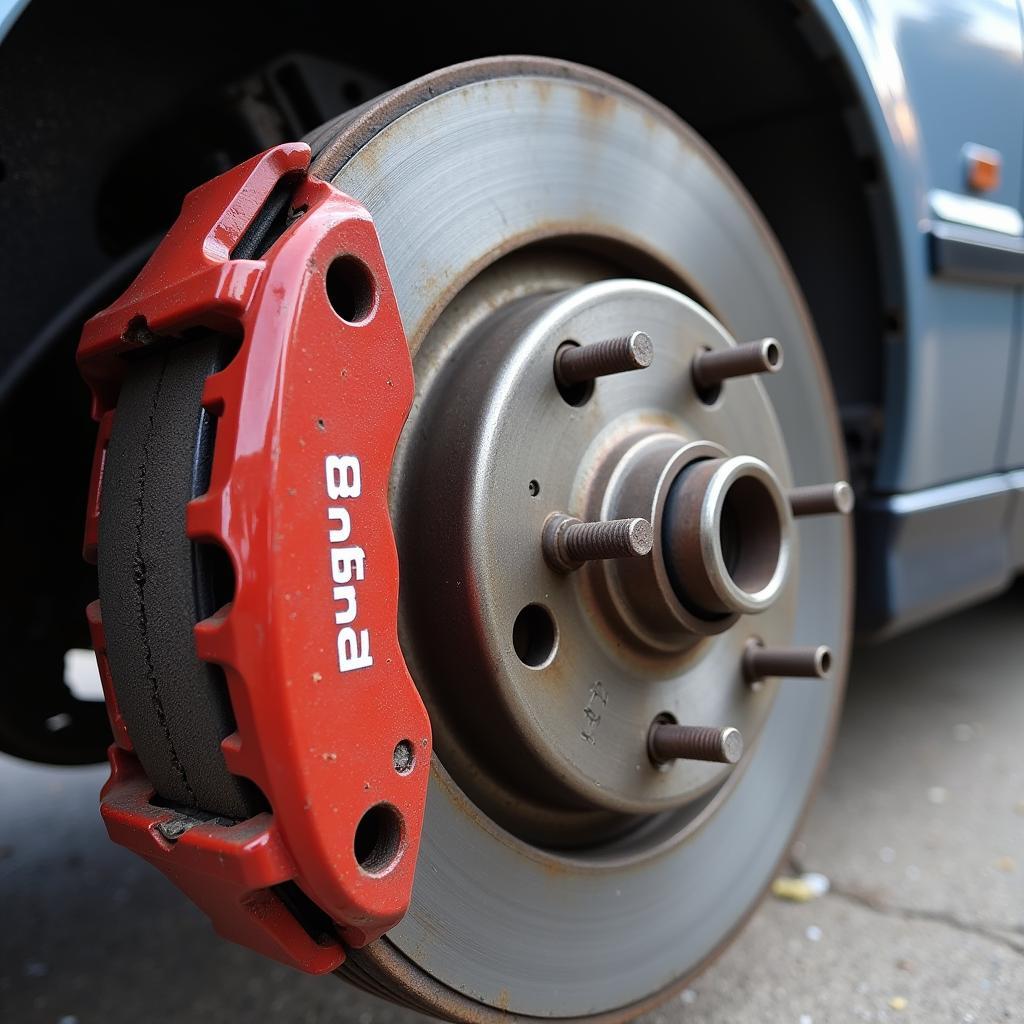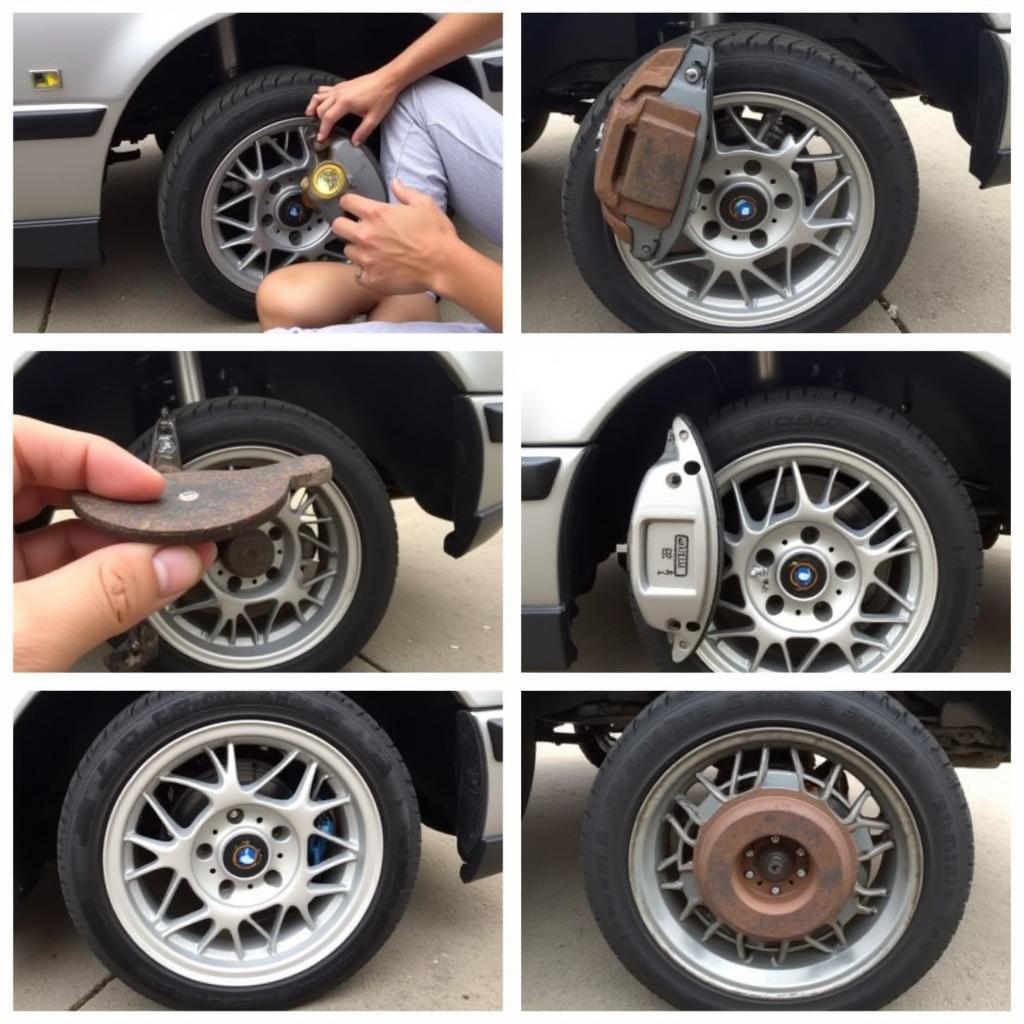The brake pad warning light on your BMW E36 is a crucial safety feature, illuminating on your dashboard to signal worn brake pads. Ignoring this warning can compromise braking performance and lead to costly repairs. This guide delves into the common causes of the BMW E36 brake pad warning light and provides practical solutions to address them.
Understanding Your E36’s Brake Pad Sensor
BMW E36 models employ a simple yet effective wear sensor system. A sensor wire, embedded within the brake pad material, triggers the warning light when the pad wears down to a critical level. This system provides a timely alert, allowing you to address the issue before further damage occurs.
Common Causes of the Brake Pad Warning Light
Several factors can illuminate the brake pad warning light on your E36:
- Worn Brake Pads: This is the most frequent cause. As you drive, your brake pads gradually wear down. When the friction material reaches a certain thinness, the sensor wire is exposed, completing a circuit and illuminating the warning light.
- Faulty Brake Pad Sensor: Like any electrical component, the sensor itself can malfunction. A broken sensor wire, damaged connector, or internal sensor failure can trigger a false warning.
- Worn Brake Rotors: While not directly related to the sensor, severely worn brake rotors can cause uneven pad wear, potentially triggering the warning light prematurely.
- Low Brake Fluid Level: Though typically indicated by a separate warning light, low brake fluid can sometimes illuminate the brake pad warning light as well. Always check your brake fluid level as a precautionary measure.
Diagnosing the Issue
- Visually Inspect the Brake Pads: The most straightforward approach is to visually check your brake pads. If the friction material is significantly thin or you can see the metal wear indicator touching the rotor, it’s time for a replacement.
- Check the Brake Pad Sensor: Carefully inspect the sensor wire for any signs of damage, such as cuts, fraying, or disconnection. A multimeter can be used to test the sensor’s continuity.
- Inspect the Brake Rotors: Examine your brake rotors for deep grooves, scoring, or excessive rust. If you notice significant wear, resurfacing or replacing the rotors might be necessary.
 Worn brake pads on a BMW E36
Worn brake pads on a BMW E36
Addressing the Brake Pad Warning Light
- Brake Pad Replacement: If your inspection reveals worn brake pads, replacement is essential. Opt for high-quality brake pads specifically designed for your E36 model for optimal braking performance and longevity.
- Brake Pad Sensor Replacement: If you discover a faulty sensor, replacing it is a relatively simple procedure. Ensure you purchase the correct sensor compatible with your E36 model.
- Brake Rotor Resurfacing or Replacement: Addressing worn brake rotors often involves resurfacing or replacement, depending on the severity of the wear. Consult a qualified mechanic to determine the best course of action.
- Brake Fluid Check and Top-up: If your brake fluid level is low, carefully top it up to the recommended level using the appropriate brake fluid type specified in your E36’s owner manual.
 Replacing brake pads on a BMW E36
Replacing brake pads on a BMW E36
Resetting the Brake Pad Warning Light
After addressing the underlying issue, you’ll need to reset the brake pad warning light. This process varies slightly depending on your E36’s specific model year, but it typically involves a combination of turning the ignition on and off and pressing the brake pedal. For detailed instructions tailored to your E36 model, consult your owner’s manual or search online for model-specific reset procedures.
“It’s crucial to address the brake pad warning light promptly. Ignoring it not only compromises your safety but can also lead to more extensive and expensive repairs down the line.” – John Miller, Certified BMW Technician
Preventive Maintenance Tips
- Regular Brake Inspections: Inspect your brake pads and rotors at least every 12,000 miles or as part of your routine maintenance schedule.
- Avoid Riding the Brakes: Minimize unnecessary braking by anticipating traffic flow and maintaining a safe distance from other vehicles.
- Quality Brake Components: Always use high-quality brake pads, rotors, and fluids designed for your E36.
Conclusion
The brake pad warning light on your BMW E36 serves as a vital safety reminder. By understanding its causes and implementing timely solutions, you can ensure optimal braking performance and maintain the safety of your vehicle. If you’re unsure about diagnosing or addressing the issue yourself, it’s always recommended to consult a qualified BMW mechanic for professional assistance.
Frequently Asked Questions
1. Can I drive with the brake pad warning light on?
While you might be able to drive for a short distance, it’s highly discouraged. Driving with worn brake pads significantly reduces your braking power and can damage other brake components.
2. How much does it cost to replace brake pads on a BMW E36?
The cost varies depending on factors such as labor rates and the type of brake pads chosen. On average, expect to pay between $150 and $300 for a brake pad replacement.
3. How often should I replace my brake rotors?
Brake rotor lifespan varies depending on driving style and conditions. As a general rule, rotors might need replacement every two to three brake pad changes.
4. Can I reset the brake pad warning light myself?
Yes, in most cases, you can reset the light yourself by following model-specific instructions. Consult your owner’s manual or search online for guidance.
5. What happens if I ignore the brake pad warning light for too long?
Ignoring the light for extended periods can lead to severe brake damage, including metal-on-metal contact, reduced braking ability, and potentially even brake failure.
